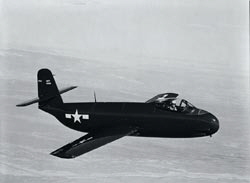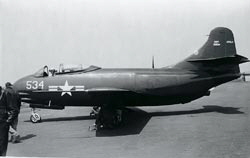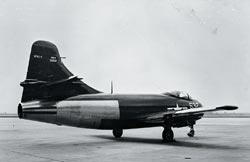|
|||||||
|
The first flight of the XF6U-1 (BuNo. 33532) was made on October 2, 1946. Fortunately, the miles of dry lake landing space allowed a successful dead-stick landing. The Westinghouse engine used a new oil mist lubrication system. All 6 gallons of engine oil were consumed and the engine froze in less than an hour. Westinghouse had no spare engine and worked overtime to provide a replacement engine some 45 days after first flight. With careful monitoring the engine performed all right thereafter, but with frequent exchanges. Shortly after the second or third flights, unprecedented rains descended on Muroc to make it a lake again. Flight operations were canceled for many weeks, except for those of deep faith who used the 1-mile-long concrete runway. During the engine and lake layovers, there was plenty of time to manually read photo-observer data and analyze it. For the uninitiated, a photo observer of 1946 was a separate instrument panel in a black box with a light source and a World War II gun camera, which could run at single frame or continuous film speed. The engineer went from frame to frame of film to get his data which consisted of counter number, indicated airspeed, rate-of-climb, altitude, engine rpm, fuel flow, free air temperature, and a few other engine-related readouts useless for airplane performance purposes. There was not room for instrumentation relating to flying qualities. Priority was on engine and flight boundary evaluation. On one flight there might be room for roll rate but not stick position, or yaw angle, but not rudder position. Correlation between pilot comment and photo observer was by means of counter number. Mach meters were new and initially unavailable at Vought, so the engineer had to use indicated airspeed, free air temperature and pressure altitude to calculate Mach numbers. (Such was life in the good old days, using a slide rule, mind you! Do you know what a slide rule is? Ask your grandfather.) On about the tenth flight, the pilot reported a strange “rudder jab,” or kick, in the rudder pedals. For the next ten flights the pilot reported more occurrences of rudder jab. There seemed to be no correlation with airspeed, engine rpm, or altitude, but calculated Mach number was 0.76 to 0.80. The problem was attributed to shock-wave interaction between the horizontal and vertical tails at their intersection, a new compressibility phenomenon. The fix was to add a torpedo-shaped fairing at the stabilizer fin intersection, which had the effect of reducing the local thickness at the intersection and increasing the local critical Mach number.
After about 6 months, the second XF6U-1 was flown from Vought’s factory in Stratford, Connecticut, to Muroc in about four short hops with ground crews at each stop. The following illustration depicts XF6U-1 with a dorsal fin added. The intention was to use the dorsal to thin the horizontal-vertical tail intersection to improve if not fix rudder jab, and, at the same time, fix the directional stability inadequacy. After about a year of flight testing at Edwards, the two airplanes were flown to the Navy’s flight test center at Patuxent River, Maryland. Further flight evaluation was conducted by Navy test pilots. With no afterburner, performance of the XF6U-1 was showing up as inadequate, especially on a hot day, when compared to the competition, which was rapidly going to higher-thrust engines, afterburners and swept wings.
More F6U: Design
|

 With a new jet engine and a predicted long takeoff distance (characteristic of the first generation jet airplane), safety of flight was a concern to Vought and the U. S. Navy. Consequently, the initial flight tests were made off-site at the dry lake in Muroc, California, later to be named Edwards Air Force Base. Some World War II bomber test facilities (principally a large modern hangar with office space), BOQ and open-air barracks were available in 1946 for flight test activities and living quarters. The wing and fuselage were disassembled at Vought’s factory in Connecticut, trucked to California and reassembled.
With a new jet engine and a predicted long takeoff distance (characteristic of the first generation jet airplane), safety of flight was a concern to Vought and the U. S. Navy. Consequently, the initial flight tests were made off-site at the dry lake in Muroc, California, later to be named Edwards Air Force Base. Some World War II bomber test facilities (principally a large modern hangar with office space), BOQ and open-air barracks were available in 1946 for flight test activities and living quarters. The wing and fuselage were disassembled at Vought’s factory in Connecticut, trucked to California and reassembled.
 Another problem was inadequate directional stability as reported by the pilot. Confirming flight test data such as rudder angle versus steady state yaw angle or cycles to damp to half amplitude from a yawed condition were not available because of instrumentation/photo observer limitations. All available hard data indicated that directional stability should have been adequate.
Another problem was inadequate directional stability as reported by the pilot. Confirming flight test data such as rudder angle versus steady state yaw angle or cycles to damp to half amplitude from a yawed condition were not available because of instrumentation/photo observer limitations. All available hard data indicated that directional stability should have been adequate.
 XF6U-1 number one was modified by the addition of an afterburner and dorsals to become the F6U-1 prototype, the first afterburner equipped service aircraft. The strips on the tailpipe were temperature-sensitive paint for survey. The fuselage aft section was aluminum in place of Metalite.
XF6U-1 number one was modified by the addition of an afterburner and dorsals to become the F6U-1 prototype, the first afterburner equipped service aircraft. The strips on the tailpipe were temperature-sensitive paint for survey. The fuselage aft section was aluminum in place of Metalite.